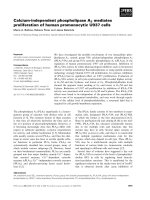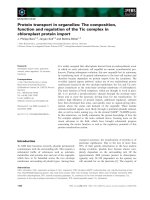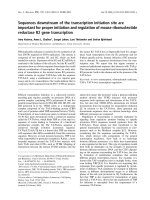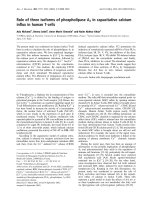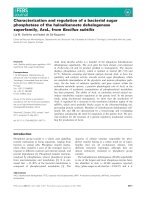FUNCTION AND REGULATION OF CALCIUM INDEPENDENT PHOSPHOLIPASE a2 IN THE ATTENUATION OF PAIN IN MICE
Bạn đang xem bản rút gọn của tài liệu. Xem và tải ngay bản đầy đủ của tài liệu tại đây (2.94 MB, 232 trang )
FUNCTION AND REGULATION OF CALCIUM-
INDEPENDENT PHOSPHOLIPASE A
2
IN THE
ATTENUATION OF PAIN IN MICE
CHEW WEE SIONG
(B. Sc. (Hons), NUS)
A THESIS SUBMITTED FOR THE DEGREE OF
DOCTOR OF PHILOSOPHY
DEPARTMENT OF ANATOMY
NATIONAL UNIVERSITY OF SINGAPORE
2015
Declaration Page
i
Declaration
I hereby declare that this thesis is my original work and it has been written by
me in its entirety. I have duly acknowledged all the sources of information
which have been used in the thesis.
This thesis has also not been submitted for any degree in any university
previously.
Chew Wee Siong
22 January 2015
Acknowledgements
ii
Acknowledgements
First and foremost, I would like to express my heartfelt gratitude and
appreciation to my supervisor, Associate Professor Ong Wei Yi, for his
patience, support and advice throughout the years. All of this would not be
possible without his constant guidance and encouragement. His dedication
towards science and research has really inspired me to work harder and
continuously challenge myself to do better. I would also like to extend my
thanks to Professor Bay Boon Huat for his support and for giving me the
opportunity to carry out my postgraduate studies at the Department of
Anatomy.
Special thanks also to Associate Professor Yeo Jin Fei, Associate
Professor Markus Wenk, Dr Kazuhiro Tanaka, Dr Ong Eng Shi, Dr
Federico Torta, Dr Pradeep Narayanaswamy and the staff of the
Department of Anatomy for their help and support in my study. Additionally, I
would like to thank my good friends and colleagues, both past and present,
who include Dr Jinatta Jittiwat, Dr Poh Kay Wee, Dr Ma May Thu, Dr
Kim Ji Hyun, Ng Pei Ern Mary, Yap Mei Yi Alicia, Ee Sze Min, Loke Sau
Yeen, Yang Hui, Chian Vee Nee, Tan Wee Shan Joey, Shalini d/o Suku
Maran, Tan Siew Hon Charlene, Tan Hui Ru Laura, Ho Fung-Yih
Christabel, Tong Jie Xin and Heng Swan Ser for all their wonderful help,
advice and companionship throughout the years.
Last but not least, I would like to thank God, my family and my loved
ones as I would not be where I am today without their endless love, support
and encouragement.
Table of Contents
iii
Table of Contents
Declaration Page………………………………………………………… …i
Acknowledgements…………………………………………… ……… ii
Table of Contents iii
Summary xii
List of Tables xv
List of Figures xvi
List of Abbreviations xx
Publications ,xxvi
Chapter 1: Introduction 1
1. Glycerophospholipids in the brain 2
1.1. Phospholipase A
2
8
1.1.1. Secretory phospholipase A
2
9
1.1.2. Cytosolic phospholipase A
2
10
1.1.3. Plasmalogen-selective phospholipase A
2
13
1.1.4. Calcium-independent phospholipase A
2
15
1.2. Polyunsaturated fatty acids 17
1.2.1. DHA in the brain 19
2. Pain 22
2.1. Orofacial pain 24
Table of Contents
iv
2.2. Pain pathway 25
2.3. Animal pain models 27
2.4. Prefrontal cortex in pain 29
3. Depression and pain 30
3.1. Antidepressants 32
3.2. Pain and antidepressant treatment 34
3.3. Tricyclic antidepressants 37
3.3.1. Amitriptyline 41
3.3.2. Nortriptyline 43
3.3.3. Maprotiline 44
Chapter 2: Aims of Study 49
Chapter 3: Role of Prefrontal Cortical iPLA
2
in
Antidepressant-Induced Antinociception 52
1. Introduction 53
2. Materials and method 55
2.1. Experimental animals 55
2.2. Pain behavioral studies 55
2.2.1. Effect of antidepressant and oligonucleotide
treatment on pain behavioral responses 55
Table of Contents
v
2.2.2. Dorsolateral prefrontal cortex intracortical
(i.c.) oligonucleotide injection 57
2.2.3. Somatosensory cortex (s.s) oligonucleotide
injection 58
2.2.4. Facial carrageenan injection and pain behavioral
assay 59
2.3. Effect of maprotiline on iPLA
2
mRNA and protein
expression in the prefrontal cortex 60
2.4. Effect of iPLA
2
knockdown on iPLA
2
protein
expression and lipid profile 61
2.5. Real-time RT-PCR 63
2.6. Western blot analysis 64
2.7. Lipidomic analysis 65
3. Results 67
3.1. Pain behavioral studies 67
3.1.1. Antidepressant and prefrontal cortex
oligonucleotide treatment groups 67
3.1.2. Maprotiline and somatosensory cortex
oligonucleotide treatment groups 70
3.2. Effect of maprotiline treatment on prefrontal cortical
iPLA
2
expression 71
3.2.1. Real-time RT-PCR 71
Table of Contents
vi
3.2.2. Western blot analysis 72
3.3. Effects of maprotiline treatment and prefrontal cortical
iPLA
2
knockdown on iPLA
2
protein expression and lipid
profile 73
3.3.1. Pain behavioral responses 73
3.3.2. Western blot analysis 75
3.3.3. Lipidomic analysis 77
4. Discussion 81
Chapter 4: Regulation of iPLA
2
Induction by Adrenergic Receptors,
MAPK/ERK and SREBP Pathways 86
1. Introduction 87
2. Materials and method 89
2.1. Cells and treatment 89
2.1.1. Cell culture 89
2.1.2. Treatment with antidepressants 90
2.1.3. Treatment with maprotiline and alpha-1
adrenergic receptor blocker 91
2.1.4. Treatment with maprotiline and alpha-2
adrenergic receptor blocker 91
2.1.5. Treatment with maprotiline and non-selective
beta adrenergic receptor blocker 92
Table of Contents
vii
2.1.6. Treatment with maprotiline and serotonin
receptor antagonist 92
2.1.7. Treatment with nortriptyline and alpha-1
adrenergic receptor blocker 93
2.1.8. Treatment with nortriptyline and serotonin
receptor antagonist 93
2.1.9. Treatment with maprotiline, cAMP/PKA
cascade inhibitors and MAPK/ERK signaling
pathway inhibitors 94
2.1.10. Treatment with alpha-1 adrenergic receptor
agonist and blocker 95
2.1.11. Treatment with alpha-1 adrenergic receptor
agonist, cAMP/PKA cascade inhibitors and
MAPK/ERK signaling pathway inhibitors 95
2.1.12. Treatment with maprotiline and SREBP
pathway inhibitors 96
2.1.13. Treatment with alpha-1 adrenergic receptor
agonist and SREBP pathway inhibitors 96
2.2. Real-time RT-PCR 97
2.3. Electrophoretic mobility shift assay 97
2.4. Western blot analysis 99
2.5. Immunocytochemistry 100
Table of Contents
viii
2.6. Statistical analysis 101
3. Results 101
3.1. Real-time RT-PCR 101
3.1.1. Effect of antidepressant treatment on
iPLA
2
expression 101
3.1.2. Effect of maprotiline and alpha-1 adrenergic
receptor blocker on iPLA
2
expression 102
3.1.3. Effect of maprotiline and alpha-2 adrenergic
receptor blocker on iPLA
2
expression 103
3.1.4. Effect of maprotiline and non-selective beta
adrenergic receptor blocker on
iPLA
2
expression 104
3.1.5. Effect of maprotiline with serotonin receptor
antagonist on iPLA
2
expression 105
3.1.6. Effect of nortriptyline with alpha-1 adrenergic
receptor blocker on iPLA
2
expression 106
3.1.7. Effect of nortriptyline and serotonin receptor
antagonist on iPLA
2
expression 107
3.1.8. Effect of maprotiline, cAMP/PKA cascade
inhibitors and MAPK/ERK signaling pathway
inhibitors on iPLA
2
expression 108
Table of Contents
ix
3.1.9. Effect of alpha-1 adrenergic receptor
agonist and alpha-1 adrenergic receptor blocker on
iPLA
2
expression 110
3.1.10. Effect of alpha-1 adrenergic receptor
agonist, cAMP/PKA cascade inhibitors and
MAPK/ERK signaling pathway inhibitors on
iPLA
2
expression 111
3.1.11. Effect of maprotiline and alpha-1
adrenergic receptor blocker on
SREBP-2 expression 112
3.1.12. Effect of maprotiline, cAMP/PKA cascade
inhibitors and MAPK/ERK signaling pathway
inhibitors on SREBP-2 expression 113
3.1.13. Effect of alpha-1 adrenergic receptor agonist
and blocker on SREBP-2 expression 115
3.1.14. Effect of alpha-1 adrenergic receptor
agonists, cAMP/PKA cascade inhibitors and
MAPK/ERK signaling pathway inhibitors
on SREBP-2 expression 116
3.1.15. Effect of maprotiline and SREBP pathway
inhibitors on iPLA
2
expression 117
Table of Contents
x
3.1.16. Treatment with alpha-1 adrenergic
receptor agonist and SREBP pathway
inhibitors on iPLA
2
expression 118
3.2. Electrophoretic mobility shift assay 119
3.2.1. Effectiveness and binding specificity of iPLA
2
oligonucleotides EMSA probe to SREBP-2 119
3.2.2. Effect of maprotiline and alpha-1 adrenergic
receptor blocker treatment on the binding of
SREBP-2 to the SRE region of the iPLA
2
gene 120
3.2.3. Effect of alpha-1 adrenergic receptor agonist
and alpha-1 adrenergic receptor blocker
treatment on the binding of SREBP-2 to the
SRE region of the iPLA
2
gene 122
3.3. Western blot analysis 124
3.4. Immunocytochemistry 125
4. Discussion 127
Chapter 5: Effect of Antidepressant Treatment on
15-LOX Expression 133
1. Introduction 134
2. Materials and method 136
2.1. Cell culture 136
2.1.1. Treatment with antidepressants 137
Table of Contents
xi
2.1.2. Treatment with maprotiline and
alpha-1 adrenergic receptor blocker 137
2.1.3. Treatment with nortriptyline and alpha-1
adrenergic receptor blocker 138
2.2. Real-time RT-PCR 138
2.3. Western blot analysis 139
2.4. Statistical analysis 139
3. Results 139
3.1. Real-time RT-PCR 139
3.1.1. Antidepressant treatment 139
3.1.2. Treatment with maprotiline and alpha-1
adrenergic receptor blocker 140
3.1.3. Treatment with nortriptyline and alpha-1
adrenergic receptor blocker 141
3.2. Western blot analysis 142
4. Discussion 143
Chapter 6: Conclusions 146
Chapter 7: References 153
Summary
xii
Summary
Calcium-independent phospholipase A
2
(iPLA
2
) is an 85 kDa enzyme
that releases docosahexaenoic acid (DHA) from glycerophospholipids.
Prefrontal cortical iPLA
2
has been shown to be important in hippocampo-
prefrontal cortical LTP and for the antidepressive effect of the antidepressant,
maprotiline. In the first part of the study, we investigated the role of prefrontal
cortical iPLA
2
in the antinociceptive effect of maprotiline and another TCA,
amitriptyline. Antidepressant treatment reduced pain behavioral responses
indicating antinociceptive effect of maprotiline and amitriptyline treatment in
a model of inflammatory orofacial pain. Injection of antisense oligonucleotide
to iPLA
2
in the dorsolateral prefrontal cortex abolished the antinociceptive
effect of maprotiline but not amitriptyline. In contrast, iPLA
2
antisense
injection in the somatosensory cortex had no effect on maprotiline-induced
antinociception. Real-time RT-PCR and Western blot results showed
increased iPLA
2
mRNA and protein expression in the prefrontal cortex after
maprotiline administration, thereby suggesting that prefrontal cortical iPLA
2
is
involved in the antinociceptive effect of maprotiline. Lipidomic analysis
showed decreased PC and increased LPC species in the prefrontal cortex after
maprotiline treatment, indicating increased iPLA
2
enzymatic activity and
endogenous release of DHA and EPA. These changes were blocked by
intracortical iPLA
2
antisense injection. Together, our results indicate an
important role of prefrontal cortical iPLA
2
in the antinociceptive effect of
maprotiline, thereby suggesting a role of iPLA
2
not only in the antidepressive,
but also antinociceptive effects of maprotiline and possibly other similar
antidepressants.
Summary
xiii
In the second part of the study, we elucidated the potential cellular
mechanisms involved in iPLA
2
expression induction, in particular the
stimulation of adrenergic receptors. Treatment of SH-SY5Y neuroblastoma
cells with maprotiline and another TCA with strong noradrenaline reuptake
inhibition activity, nortriptyline, as well as the alpha-1 adrenergic receptor
agonist, phenylephrine, resulted in increased iPLA
2
expression. This increase
was blocked by inhibitors to the alpha-1 adrenergic receptors, MAPK/ERK,
and sterol regulatory element binding protein (SREBP). Maprotiline and
phenylephrine induced binding of SREBP-2 to the SRE region on the iPLA
2
gene, as determined by electrophoretic mobility shift assay (EMSA). Our
results indicate that stimulation of adrenergic receptors increased iPLA
2
expression via MAPK/ERK and SREBP-2
Docosanoids such as resolvin D1 (RvD1) have been shown to be
effective in treatment of inflammatory conditions and pain. RvD1 is
metabolized from DHA by 15-lipoxygenase (15-LOX). In the last part of the
study, we postulate that besides inducing iPLA
2
expression, antidepressants
with strong noradrenaline reuptake inhibition activity will similarly induce an
increase in 15-LOX expression. Real-time RT-PCR showed a significant
increase in 15-LOX mRNA expression after maprotiline and nortriptyline
treatment which was blocked by prazosin. This was supported by Western blot
analysis which showed similar results. Overall, our findings suggest that
treatment with antidepressants, especially those with strong noradrenaline
reuptake inhibition activity, will induce iPLA
2
expression leading to increased
DHA levels and subsequent production of resolvins via a concurrent increase
in 15-LOX expression. The increase in DHA and its metabolites levels may
Summary
xiv
then contribute to the antidepressant-induced antinociception by facilitating
activity or plasticity in the dorsolateral prefrontal cortex to stimulate the PAG
and descending pain inhibitory pathway.
List of Tables
xv
List of Tables
Table 1.1 Differences between somatic and visceral pain 24
Table 1.2 Potencies and elimination profile of amitriptyline,
nortriptyline and maprotiline based on radioactive
ligand transport competition assays 48
List of Figures
xvi
List of Figures
Fig. 1.1 Phospholipase enzymes and their site of action 8
Fig. 1.2 Structure of several PUFAs 18
Fig. 1.3 Synthesis and metabolites of omega-3 and omega-6
fatty acids as well as the enzymes involved 19
Fig. 1.4 Transmission of sensory inputs to the brain 27
Fig. 1.5 Basic structure of carrageenan 28
Fig. 1.6 Sites of action of antidepressants 34
Fig. 1.7 Amitriptyline structure 42
Fig. 1.8 Nortriptyline structure 44
Fig. 1.9 Maprotiline structure 46
Fig. 1.10 Selectivity for inhibition of noradrenaline reuptake
by several TCAs 47
Fig. 3.1 Schematic flowchart of the experimental outline and
animal grouping for the pain behavioral studies 57
Fig. 3.2 Schematic flowchart of the experimental outline and
animal grouping for the real-time RT-PCR, Western blot and
lipidomic analyses 62
Fig. 3.3 Pain behavioral responses – antidepressant treatment
and prefrontal cortex injection 69
Fig. 3.4 Pain behavioral responses - maprotiline treatment
and somatosensory injection 71
Fig. 3.5 Effect of maprotiline treatment on iPLA
2
mRNA
expression in the mouse prefrontal cortex 72
Fig. 3.6 Effect of maprotiline treatment on iPLA
2
protein
expression in the mouse prefrontal cortex 73
Fig. 3.7 Pain behavioral responses – maprotiline treatment and
prefrontal cortex injection 75
Fig. 3.8 Effect of oligonucleotide treatment on iPLA
2
protein
expression in the mouse prefrontal cortex after
maprotiline treatment 76
List of Figures
xvii
Fig. 3.9 Lipidomic analysis - phosphatidylcholine species 78
Fig. 3.10 Lipidomic analysis - lysophosphatidylcholine species 79
Fig. 3.11 Lipidomic analysis - ceramide species 80
Fig. 3.12 Lipidomic analysis - sphingomyelin species 81
Fig. 4.1 Real time RT-PCR results. Effect of antidepressant
treatment on iPLA
2
mRNA expression in SH-SY5Y cells 102
Fig. 4.2 Real time RT-PCR results. Effect of maprotiline and
alpha-1 adrenergic receptor blocker, prazosin, on
iPLA
2
mRNA expression in SH-SY5Y cells 103
Fig. 4.3 Real time RT-PCR results. Effect of maprotiline and
alpha-2 adrenergic receptor blocker, idazoxan, treatment on
iPLA
2
mRNA expression in SH-SY5Y cells 104
Fig. 4.4 Real time RT-PCR results. Effect of maprotiline and
beta adrenergic receptor blocker, nadolol, treatment on
iPLA
2
mRNA expression in SH-SY5Y cells 105
Fig. 4.5 Real time RT-PCR results. Effect of maprotiline and
serotonin receptor antagonist, WAY100635, treatment on
iPLA
2
mRNA expression in SY-SY5Y cells 106
Fig. 4.6 Real time RT-PCR results. Effect of nortriptyline and
alpha-1 adrenergic receptor blocker, prazosin, on
iPLA
2
mRNA expression in SH-SY5Y cells 107
Fig. 4.7 Real time RT-PCR results. Effect of nortriptyline and
serotonin receptor antagonist, WAY100635, treatment on
iPLA
2
mRNA expression in SH-SY5Y cells 108
Fig. 4.8 Real time RT-PCR results. Effect of maprotiline
together with PKA inhibitor, H-89, and ERK
inhibitor, FR180204, treatment on iPLA
2
mRNA
expression in SH-SY5Y cells 109
Fig. 4.9 Real time RT-PCR results. Effect of maprotiline
together with PKA inhibitor, PKI, and MAPK/ERK pathway
inhibitor, PD98059, treatment on iPLA
2
mRNA
expression in SH-SY5Y cells 110
Fig. 4.10 Real time RT-PCR results. Effect of alpha-1 agonist,
phenylephrine, and alpha-1 adrenergic receptor blocker,
prazosin, on iPLA
2
mRNA expression in SH-SY5Y cells 111
List of Figures
xviii
Fig. 4.11 Real time RT-PCR results. Effect of alpha-1 agonist,
phenylephrine, and PKA inhibitor, H-89, and ERK
inhibitor, FR180204, treatment on iPLA
2
mRNA
expression in SH-SY5Y cells 112
Fig. 4.12 Real time RT-PCR results. Effect of maprotiline and
alpha-1 adrenergic receptor blocker, prazosin, on
SREBP-2 mRNA expression in SH-SY5Y cells 113
Fig. 4.13 Real time RT-PCR results. Effect of maprotiline together
with PKA inhibitor, H-89, and ERK inhibitor,
FR180204, treatment on SREBP-2 mRNA expression
in SH-SY5Y cells 114
Fig. 4.14 Real time RT-PCR results. Effect of maprotiline together
with PKA inhibitor, PKI, and MAPK/ERK pathway inhibitor,
PD98059, treatment on SREBP-2 mRNA expression
in SH-SY5Y cells 115
Fig. 4.15 Real time RT-PCR results. Effect of alpha-1
agonist, phenylephrine, and alpha-1 adrenergic
receptor blocker, prazosin, on SREBP-2 mRNA expression
in SH-SY5Y cells 116
Fig. 4.16 Real time RT-PCR results. Effect of alpha-1
agonist, phenylephrine, and PKA inhibitor, H-89, and
ERK inhibitor, FR180204, treatment on SREBP-2 mRNA
expression in SH-SY5Y cells 117
Fig. 4.17 Real time RT-PCR results. Effect of maprotiline
and SREBP pathway inhibitors, betulin and PF-429242,
treatment on iPLA
2
mRNA expression in SH-SY5Y cells 118
Fig. 4.18 Real time RT-PCR results. Effect of alpha-1
adrenergic receptor agonist, phenylephrine, and SREBP
pathway inhibitors, betulin and PF-429242, treatment on iPLA
2
mRNA expression in SH-SY5Y cells 119
Fig. 4.19 EMSA blot showing the effectiveness and binding
specificity of iPLA
2
oligonucleotides EMSA probe
to SREBP-2 120
Fig. 4.20 EMSA blot densitometric analysis results.
(A) EMSA blot and (B) densitometric analysis on the
effects of maprotiline treatment and alpha-1 adrenergic
receptor blocker, prazosin, on SREBP-2 binding to the
SRE region of iPLA
2
gene 121
Fig. 4.21 EMSA blot densitometric analysis results.
(A) EMSA blot and (B) densitometric analysis on the effect
List of Figures
xix
of alpha-1 adrenergic receptor agonist, phenylephrine,
and alpha-1 adrenergic receptor blocker, prazosin,
treatment on SREBP-2 binding to the SRE region
of iPLA
2
gene 123
Fig. 4.22 Western blot densitometric analysis results.
(A) Western blot and (B) densitometric analysis on the
effect of maprotiline and alpha-1 adrenergic receptor
blocker, prazosin, treatment on SREBP-2 expression
in SH-SY5Y cells 124
Fig. 4.23 Immunocytochemistry photos of iPLA
2
expression in
SH-SY5Y cells after maprotiline, alpha-1 adrenergic receptor
blocker, prazosin, and SREBP pathway blocker,
betulin treatment 126
Fig. 4.24 Fluorescence intensity of iPLA
2
expression in SH-SY5Y
cells after maprotiline, alpha-1 adrenergic receptor
blocker, prazosin, and SREBP pathway inhibitor,
betulin treatment 127
Fig. 5.1 The metabolic steps involved in generation of
neuroprotectin D1 (NPD1) and resolvin D1 (RvD1)
from DHA 136
Fig. 5.2 Real time RT-PCR results. Effect of antidepressant
treatment on 15-LOX mRNA expression in SH-SY5Y cells 140
Fig. 5.3 Real time RT-PCR results. Effect of maprotiline and
alpha-1 adrenergic receptor blocker, prazosin, on 15-LOX
mRNA expression in SH-SY5Y cells 141
Fig. 5.4 Real time RT-PCR results. Effect of nortriptyline
and alpha-1 adrenergic receptor blocker, prazosin, on
15-LOX mRNA expression in SH-SY5Y cells 142
Fig. 5.5 Western blot densitometric analysis results.
(A) Western blot and (B) densitometric analysis on
the effect of maprotiline and alpha-1 adrenergic
receptor blocker, prazosin, treatment on 15-LOX
expression in SH-SY5Y cells 143
Fig. 6.1 Diagram showing the potential mechanisms
and signaling pathways involved in antidepressant-induced
antinociception in the (A) synaptic cleft, (B) neuronal cell
and (C) brain 149
Fig. 6.2 Summary of the potential mechanisms and
signaling pathways involved in antidepressant-induced
antinociception 151
List of Abbreviations
xx
List of Abbreviations
15-LOX 15-lipoxygenase
AA Arachidonic acid
AC Adenylate cyclase
Acyl-CoA Acyl-Coenzyme A
ADHD Attention-deficit hyperactivity disorder
ALA α-linolenic acid
AMPA α-amino-3-hydroxy-5-methyl-4-isoxazolepropionic acid
ANOVA Analysis of variance
ATP Adenosine triphosphate
ATPase Adenosine triphosphatase
BSA Bovine serum albumin
Ca
2+
Calcium
cAMP Cyclic adenosine monophosphate
Cer Ceramide
CFA Complete Freund’s adjuvant
CID Collision-induced dissociation
CO
2
Carbon dioxide
COX Cyclooxygenase
cPLA
2
Cytosolic phospholipase A
2
List of Abbreviations
xxi
CT Threshold cycle
CYP Cytochrome P450
DAG Diacylglycerol
DAPI 4',6-diamidino-2-phenylindole
DHA Docosahexaenoic acid
DMEM Dulbecco's Modified Eagle Medium
DMSO Dimethyl sulfoxide
DNA Deoxyribonucleic acid
DTT Dithiothreitol
EBNA Epstein-Barr Nuclear Antigen
EMSA Electrophoretic mobility shift assay
EPA Eicosapentaenoic acid
EPSCs Excitatory postsynaptic currents
ER Endoplasmic reticulum
ERK Extracellular-signal-regulated kinase
FBS Fetal bovine serum
FDA Food and Drug Administration
GTP Guanosine triphosphate
GTPase Guanosine triphosphatase
GST Glutathione S-transferase
List of Abbreviations
xxii
i.c. Intracortical
i.p. Intraperitoneal
IASP International Association for the Study of Pain
IgG Immunoglobulin G
IP
3
Inositol 1,4,5-trisphosphate
iPLA
2
Calcium-independent phospholipase A
2
ISTD Internal standard
K
+
Potassium
KCl Potassium chloride
LA Linoleic acid
LC-MS Liquid chromatography-mass spectrometry
LOX Lipoxygenase
LPC Lysophosphatidylcholine
LTP Long term potentiation
MAO Monoamine oxidase
MAOI Monoamine oxidase inhibitors
MAPK Mitogen-activated protein kinase
MDD Major Depressive Disorder
MRM Multiple Reaction Monitoring
mRNA Messenger ribonucleic acid
List of Abbreviations
xxiii
Na
+
Sodium
NADPH Nicotinamide adenine dinucleotide phosphate –
(reduced form)
NMDA N-methyl-D-aspartate
NPD1 Neuroprotectin D1
NRIs Noradrenaline reuptake inhibitors
NRM Nucleus raphe magnus
PAF Platelet activating factor
PAG Periaqueductal gray
PBS Phosphate-buffered saline
PC Phosphatidylcholine
PCR Polymerase chain reaction
PE Phosphatidylethanolamine
PI Phosphatidylinositol
PKA Protein kinase A
PKC Protein kinase C
PLA
1
Phospholipase A
1
PLA
2
Phospholipase A
2
PLC Phospholipase C
PLD Phospholipase D
List of Abbreviations
xxiv
PlsEtn-selective Plasmalogen-selective
PS Phosphatidylserine
PtdIns(4,5)P2 Phosphatidylinositol-4,5-bisphosphate
PUFAs Polyunsaturated fatty acids
PVDF Polyvinylidene difluoride
RIMA Reversible inhibitors of monoamine oxidase type A
rTMS Repetitive transcranial magnetic stimulation
RvD1 Resolvin D1
RvE1 Resolvin E1
s.s. Somatosensory cortex
S1P Site-1 protease
S2P Site-2 protease
SCAP SREBP cleavage-activating protein
SDS Sodium dodecyl sulfate
SM Sphingomyelin
SNRIs Serotonin-noradrenaline reuptake inhibitors
sPLA
2
Secretory phospholipase A
2
SRE Sterol regulatory element
SREBP Sterol regulatory element-binding protein
SSRIs Selective serotonin reuptake inhibitors

